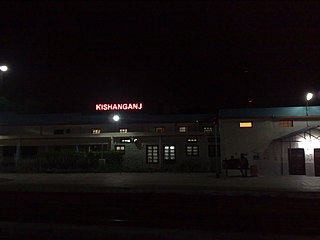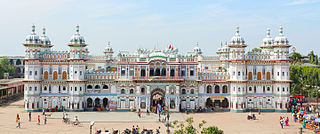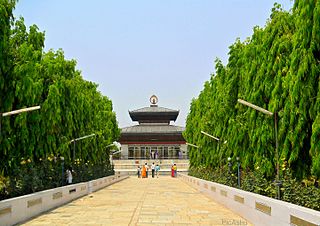Mithila may refer to:
Mithila may refer to:
Araria is a city and a municipality that is the headquarters of Araria district in the Indian state of Bihar. Araria is situated in the northern part of Bihar.
Madhepura is a municipality in Madhepura district in the Indian state of Bihar. It stands at the centre of Kosi ravine, It was called Madhyapura- a place centrally situated which was subsequently transformed as Madhipura into present Madhepura. It is surrounded by Araria and Supaul districts in the north, Khagaria and Bhagalpur districts in the south, Purnia district in the east and Saharsa district in the West.
Supaul is a town and a municipality that is headquarters of Supaul district in the Indian state of Bihar. Supaul is the administrative headquarters of this district. There Are 11 block under the Supaul district Supaul, Kishanpur, Saraigarh-Bhaptiyahi, Pipra, Triveniganj, Raghopur, chhatapur, Nirmali, Marauna, Basantpur and pratapganj.

Janaka is the King of Videha who ruled from Mithila, in the Hindu epic Ramayana. Janaka was married to Sunayana. He is the father of Sita, the female protagonist of the epic, and Urmila.

Madhubani art is a style of painting practiced in the Mithila region of India and Nepal. It is named after the Madhubani district of Bihar, India, which is where it originated. Jitwarpur and Ranti are the two most notable cities associated with the tradition and evolution of Madhubani art. The art was traditionally practiced by female members. Artists create these paintings using a variety of mediums, including their own fingers, or twigs, brushes, nib-pens, and matchsticks. The paint is created using natural dyes and pigments. The paintings are characterized by their eye-catching geometrical patterns. There is ritual content for particular occasions, such as birth or marriage, and festivals, such as Holi, Surya Shasti, Kali Puja, Upanayana, and Durga Puja.

Supaul district is one of the thirty-eight districts of Bihar, India. The town Supaul is the district's administrative headquarters. The district, which was split from the former Saharsa district on 14 March 1991, occupies 2,410 km2 (931 sq mi).

Kishanganj district is one of the thirty-eight districts of Bihar state, India, and Kishanganj town is the administrative headquarters of this district. Kishanganj district is a part of Purnia division (Seemanchal).

Saharsa is one of the thirty-eight districts of Bihar, India. Saharsa city is the administrative headquarters of this district. Saharsa district is a part of the Kosi Division and it became a district on 1 April 1954 and has subsequently become smaller with other districts being carved from it, most notably Madhepura in 1981.

Kosi division is an administrative geographical unit of Bihar state of India. Saharsa is the administrative headquarters of the division. Currently (2022), the division consists of Saharsa district, Madhepura district, and Supaul district.

The Vajjika or VrijikaLeague, Confederacy, or Sangha, also called simply Vajji or Vriji, was an ancient Indo-Aryan tribal league which existed during the later Iron Age period in north-east South Asia.

Videha was an ancient Indo-Aryan tribe of north-eastern Indian subcontinent whose existence is attested during the Iron Age. The population of Videha, the Vaidehas, were initially organised into a monarchy but later became a gaṇasaṅgha, presently referred to as the Videha Republic, which was part of the larger Vajjika League.

Maithils, also known as Maithili people, are an Indo-Aryan ethno-linguistic group from the Indian subcontinent, who speak the Maithili language as their native language. They inhabit the Mithila region, which comprises Northern and Eastern Bihar and Northeastern Jharkhand in India and some adjoining districts of Nepal constituting Madhesh Province in addition to some terai districts of Bagmati and Koshi Provinces.

Janaki Mandir is a Hindu temple in Janakpurdham, Nepal, dedicated to the Hindu goddess Sita. It is an example of Koiri Hindu architecture. Fully built in bright white and constructed in an area of 1,480 square metres in the Mithila Kingdom, it is a three-storied structure made entirely of stone and marble.

Janakpurdham or Janakpur, is a sub-metropolitan city in Dhanusha district, Madhesh Province, Nepal. The city is a hub for religious and cultural tourism. A headquarter of Dhanusha district, Janakpur is also the capital for Madhesh Province.

Mithila, also known as Tirhut, Tirabhukti and Mithilanchal, is a geographical and cultural region of the Indian subcontinent bounded by the Mahananda River in the east, the Ganges in the south, the Gandaki River in the west and by the foothills of the Himalayas in the north. It comprises certain parts of Bihar and Jharkhand of India and adjoining districts of the Koshi Province, Bagmati Pradesh and Madhesh Province of Nepal. The native language in Mithila is Maithili, and its speakers are referred to as Maithils.
Mithila is a geographical and cultural region located in the Indian subcontinent. The native language is known as Maithili and its speakers are referred to as Maithils. The majority of the Mithila region falls within modern-day India, more specifically in the state of Bihar. Mithila is bounded in the north by the Himalayas, and in the south, west and east by the Ganges, Gandaki and Mahananda respectively. It extends into the southeastern Terai of Nepal. This region was also called Tirabhukti, the ancient name of Tirhut.
Giddha is a village development committee in Dhanusa District in the Janakpur Zone of south-eastern Nepal Municipality called Videha. At the time of the 1991 Nepal census it had a population of 4,147 persons living in 714 individual households.

Gajendra Thakur is an Indian author. He writes in the Maithili language, a language spoken in Northern Bihar and South-Eastern Nepal. He is an author, lexicographer, historian ; and palaeographer, he has deciphered ancient and medieval palm leaf inscriptions in Tirhuta script of Maithili Language. These panjis are genealogical records of Maithil Brahmin community of Mithila region and contain details of around 100 inter-caste marriages. Besides it provides written historical records of people and personalities, hitherto considered mythical ones. Besides he deciphered scripts inscribed on temples/ dilapidated buildings throughout the length and breadth of Mithila.
Mithila Madhya Parikrama is an annual periodic journey of the central part of the ancient Mithila. It is held every year between the months of Kartik (October–November), Falgun (February–March) and Baishakh (April–May). But nowadays only Falgun (February–March) journey is famous. It is a circular journey of the central part of the Ancient Mithila. It covers a distance of 128 km circular path. It is mentioned in the epic Mithila Mahatmya which was composed in the 18th century.